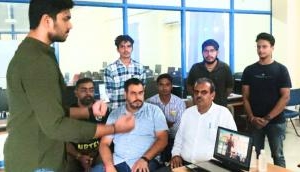Can't digest this: after wearable tech, it's time for swallowables

It's no secret that wearable tech is all the rage. From the Fitbits of the world to the far dafter Pavloks and a whole spectrum of stupidity and genius in between, wearable technology now allows you to monitor your bodily functions like never before. It's now literally possible to wear your heart on your sleeve.
Well, your heartrate at least.
Also read: Food labels are passe. New molecular sensor reveals what's really in your food
But given that wearable tech only comes in contact with skin, it has its limitations. Which is why scientists took the adage 'the fastest way to a man's heart is through his stomach' and applied it to technology. Say hello to the next tech set to revolutionlise how you monitor your health: swallowables.
In 2015, researchers at MIT showcased their development of an ingestible capsule capable of tracking body functions in detail. Once ingested, the capsule settles in the digestive tract where it begins to monitor the goings-on within your body.
By encasing a single sensor consisting of a microphone, thermometer and battery inside the capsule, the scientists are able to track core body temperature, cardiac as well as respiratory functions. A radio-transmitter embedded within the capsule then transmits this data to an electronic device such as a smartphone or a computer. After two days the pill passes out of the digestive tract, making it ideal for in-depth monitoring during a stay in the hospital.
While the short lifespan of MIT's swallowables may seem like a drawback compared to wearables, the increased accuracy of the data more than makes up for it. Further, in cases like those of burn victims and trauma patients, where monitoring vital signs through the skin is almost impossible, an ingestible alternative such as MIT's is a godsend.
But MIT's technology is still in the developmental phase. Still, there's actual swallowable tech that's already approved for use.
The memory pill
No, this isn't a pill to boost memory, but something to help you keep track of your pill intake.
Proteus Digital Health has designed a sensor called the Ingestion Event Marker (IEM) that can be attached to pills and ingested. Once ingested, the sensor reacts with stomach fluids that power it. It then sends a time-stamped signal about the details of the ingested pill to a wearable patch worn by the user.
The patch, which is Bluetooth enabled, then sends the details of every pill swallowed to a smartphone app, or to the cloud so that it can be monitored by family, doctors or caregivers.
While on the surface it may not seem like the most revolutionary invention, it's managed to raise over US $400 million in funding from some of the biggest pharma companies including Novartis and Medtronic.
Why? Because though it may seem like the simplest of things, remembering to take your medication is something a lot of us struggle with. In fact, according to World Health Organisation estimates, over half of all people suffering from chronic illnesses slip up when it comes to taking their prescribed medication.
Even so, you'd imagine a few lapses of memory wouldn't amount to much. Except they really do when it comes to serious illnesses. In the US alone, failure by older patients to take medications as prescribed could add to the national health care bill by over US $100 billion. Some estimates put the figure as high as $300 billion. To put that in perspective, the US' entire federal budget for education comes in at a comparatively paltry US $77.4 billion.
Also read: A robot just performed autonomous surgery. The future is now present
But swallowables aren't just to monitor health. In some cases, they can actually do a world of good while inside you.
The pig in a pill
MIT researchers really seem to be doubling down on the swallowable scene. After inventing swallowable pills to monitor your body functions, they've now come up with swallowables to help get those swallowables out should they get stuck.
Not just other swallowables either. The revolutionary technology could be the solution to the problem of children treating small objects like food. The researchers have developed a tiny 'origami' robot that they've encased in an ice pill.
Once ingested, the pill travels to the stomach where it melts, allowing the robot to unfold. Then, controlled by external magnetic fields, the robot can be moved and guided to capture and remove small objects stuck in the stomach. This is something that usually takes a few days on its own and sometimes even requires surgery.
There's just one drawback with the technology though. It's made of pig intestines so devout Jews and Muslims beware. The advantage of this, though, is that the robot is mostly biodegradable. While the technology has not been tested in real-life situations, having been restricted thus far to a simulated esophagus and stomach, scientists expect it to translate seamlessly to a real-life environment.
Even better, they expect to improve the robot to be able to patch up minor wounds and administer medicine. Maybe even autonomously. Now that's food for thought.
Edited by Durga M Sengupta
Also read: Shocking tech: this wristband electrocutes you into ditching a bad habit
First published: 16 May 2016, 10:20 IST






![BJP's Kapil Mishra recreates Shankar Mahadevan’s ‘Breathless’ song to highlight Delhi pollution [WATCH] BJP's Kapil Mishra recreates Shankar Mahadevan’s ‘Breathless’ song to highlight Delhi pollution [WATCH]](https://images.catchnews.com/upload/2022/11/03/kapil-mishra_240884_300x172.png)

![Anupam Kher shares pictures of his toned body on 67th birthday [MUST SEE] Anupam Kher shares pictures of his toned body on 67th birthday [MUST SEE]](https://images.catchnews.com/upload/2022/03/07/Anupam_kher_231145_300x172.jpg)






